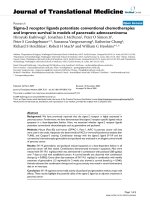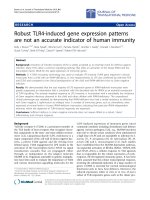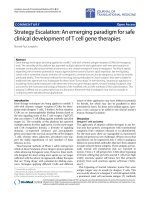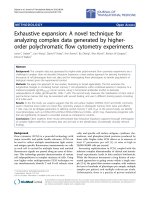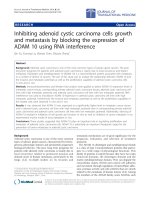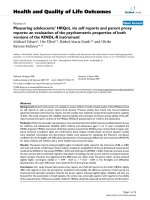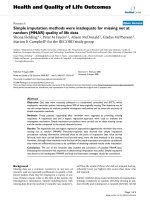báo cáo hóa học: " Simple imputation methods were inadequate for missing not at random (MNAR) quality of life data" pot
Bạn đang xem bản rút gọn của tài liệu. Xem và tải ngay bản đầy đủ của tài liệu tại đây (284.5 KB, 9 trang )
BioMed Central
Page 1 of 9
(page number not for citation purposes)
Health and Quality of Life Outcomes
Open Access
Research
Simple imputation methods were inadequate for missing not at
random (MNAR) quality of life data
Shona Fielding*
1
, Peter M Fayers
1,2
, Alison McDonald
3
, Gladys McPherson
3
,
Marion K Campbell
3
for the RECORD study group
Address:
1
Department of Public Health, University of Aberdeen, UK,
2
Department of Cancer Research and Molecular Medicine, Faculty of
Medicine, Norwegian University of Science and Technology, Trondheim, Norway and
3
Health Services Research Unit, University of Aberdeen, UK
Email: Shona Fielding* - ; Peter M Fayers - ; Alison McDonald - ;
Gladys McPherson - ; Marion K Campbell -
* Corresponding author
Abstract
Objective: QoL data were routinely collected in a randomised controlled trial (RCT), which
employed a reminder system, retrieving about 50% of data originally missing. The objective was to
use this unique feature to evaluate possible missingness mechanisms and to assess the accuracy of
simple imputation methods.
Methods: Those patients responding after reminder were regarded as providing missing
responses. A hypothesis test and a logistic regression approach were used to evaluate the
missingness mechanism. Simple imputation procedures were carried out on these missing scores
and the results compared to the actual observed scores.
Results: The hypothesis test and logistic regression approaches suggested the reminder data were
missing not at random (MNAR). Reminder-response data showed that simple imputation
procedures utilising information collected close to the point of imputation (last value carried
forward, next value carried backward and last-and-next), were the best methods in this setting.
However, although these methods were the best of the simple imputation procedures considered,
they were not sufficiently accurate to be confident of obtaining unbiased results under imputation.
Conclusion: The use of the reminder data enabled the conclusion of possible MNAR data.
Evaluating this mechanism was important in determining if imputation was useful. Simple imputation
was shown to be inadequate if MNAR are likely and alternative strategies should be considered.
Background
Missing data are a common occurrence in any area of
research, and are especially problematic in quality of life
(QoL) studies. Data may be missing for a variety of rea-
sons. If these reasons relate to the QoL of the patient, the
missingness is informative. Simply excluding those with
missing data from the analysis ("complete case analysis"),
will bias the results if those who did not respond had sig-
nificantly lower (or higher) QoL scores than those who
did respond.
Rubin [1] defines three main mechanisms of missing data:
missing completely at random (MCAR), missing at ran-
dom (MAR) and missing not at random (MNAR). MCAR
Published: 4 August 2008
Health and Quality of Life Outcomes 2008, 6:57 doi:10.1186/1477-7525-6-57
Received: 11 February 2008
Accepted: 4 August 2008
This article is available from: />© 2008 Fielding et al; licensee BioMed Central Ltd.
This is an Open Access article distributed under the terms of the Creative Commons Attribution License ( />),
which permits unrestricted use, distribution, and reproduction in any medium, provided the original work is properly cited.
Health and Quality of Life Outcomes 2008, 6:57 />Page 2 of 9
(page number not for citation purposes)
requires very strong assumptions. An observation is said
to be MCAR if the missingness is independent of all
observed and unobserved (i.e. previous, current and
future) QoL assessments [2]. For example a patient may
simply forget to post the questionnaire back. Observa-
tions can also be MCAR if the missingness only depends
on values of fixed covariates that are measured prior to
treatment assignment – often termed covariate-dependent
dropout. For example, if elderly patients were less likely to
respond, missingness would be dependent on age group.
A more relaxed assumption about the missing data mech-
anism is missing at random (MAR), where missingness is
independent of all unobserved (missing or future) QoL
values, although it may be dependent on the observed val-
ues. The "observed values" may comprise a baseline meas-
ure of QoL or a previous assessment and any appropriate
covariates.
A process that is neither MCAR nor MAR is called missing
not at random (MNAR). MNAR occurs if missingness
depends not only on the observed data but also on the
unobserved (missing) values. An example is that a person
with reduced QoL due to side effects of treatment may be
less likely to return the questionnaire. The missing value
depends on the unobserved QoL scores and the missing-
ness mechanism is informative.
Many investigators have explored approaches to deter-
mine the mechanism of missingness. They have either
generated artificial datasets using simulation techniques
[3], or have made use of existing datasets in which missing
data were then artificially created [4]. These procedures
are potentially misleading: the missing patterns are prede-
termined and pre-specified, and usually the performance
of the various tests can be anticipated through the known
mechanism that was used to generate the samples.
One approach to deal with missing data is simple imputa-
tion, which is the process whereby a single estimated
value for the missing observation is obtained, thereby
enabling standard statistical methods to be applied to the
augmented data set. Various methods can be imple-
mented to impute the missing data. However, the accu-
racy of imputation cannot normally be determined, as the
true values are not known. Various authors have explored
the potential accuracy of imputation methods by artifi-
cially removing data from a dataset and treating it as miss-
ing [3-5]. This is a circular argument, as noted above,
because the data are either removed at random or accord-
ing to some known and pre-specified pattern. In practice,
the major analytical problem is that one does not know
the exact missing mechanism.
Engels and Diehr [6] noted the need to use data with real
missing patterns, and attempted to overcome these prob-
lems by using a dataset where a value was observed after
one or more missing values had occurred; the observed
value was treated as the true value for the missing data at
the preceding time points. Various imputation methods
were applied for the missing values, and the results com-
pared against the observed value to assess accuracy of the
imputation methods. As Engels and Diehr [6] comment,
"this analysis hinges on the similarity of a known value
following a string of missing values to other observations
that are missing at that same time."
Poor compliance with collecting QoL data is a well-recog-
nised problem in clinical trials. In an attempt to minimise
the level of missing data, the Health Services Research
Unit (HSRU) at the University of Aberdeen makes strenu-
ous efforts to recover QoL data. When QoL questionnaires
are not returned, HSRU not only issues repeated remind-
ers (including telephone contact), but in addition offers
to interview patients by telephone. Therefore, a propor-
tion of patients who initially had missing data – as would
have been the case in most clinical trials – then have
"true" values which were subsequently recovered. This
provided a unique opportunity to investigate the perform-
ance of tests for identifying missing data mechanisms and
methods of imputation, because the results could be eval-
uated against the data that was later recovered.
Methods
The dataset
The RECORD trial was a randomised placebo-controlled
trial of daily oral vitamin D and calcium in the secondary
prevention of osteoporosis-related fractures in older peo-
ple [7]. Patients' QoL was assessed by postal question-
naire at 4, 12, 24, 36 and 48 months. The four month data
were considered the "baseline" measure as QoL for many
patients at entry to the trial would be artificially low while
they were being treated in hospital for their primary frac-
ture. The questionnaire included the five items of the
EuroQoL EQ5D [8], and the 12-item SF12 questionnaire
[9]. The EQ5D produces a single QoL score, and the SF12
gives two summary scores, the physical and mental com-
ponent scores (PCS and MCS). The results for EQ5D data
are presented here. At each occasion, if a participant did
not return the questionnaire within two weeks, up to two
reminders were issued (two weeks apart). Patients who
returned the questionnaire without needing a reminder
were considered 'immediate-responders', while those that
returned a questionnaire after one or two reminders pro-
vided 'missing yet known' data, and were termed
'reminder-responders'. In the analyses that follow, the
scores obtained for reminder-responders were regarded as
missing – what they would have been in some clinical
studies.
Health and Quality of Life Outcomes 2008, 6:57 />Page 3 of 9
(page number not for citation purposes)
Identifying the missing data mechanism
Hypothesis tests
The pattern of missing data can be described as either "ter-
minal", when no further observations were made on a
patient after a set of complete observations, or "intermit-
tent", in which case one or more observations for a patient
were missing before a subsequent observation was
observed. It was possible for a patient to have a mixed pat-
tern, with a period of intermittent dropout followed by
terminal dropout.
There are a number of hypothesis tests that can be carried
out to test the assumption of MCAR. Little [10] developed
a test based on the means of the variable of interest under
the different missing data patterns (including intermittent
and terminal missingness). Alternative hypothesis tests
have been suggested by Diggle [11], Ridout [12] and List-
ing and Schlittgen [13], all requiring terminal missing-
ness. Diggle [11] used an approach which tests whether
the subset about to dropout are a random sample of the
whole population. Ridout [12] adopted a similar
approach to Diggle by utilising logistic regression. Listing
and Schlittgen [13] proposed a test based on means. These
alternatives to Little [10], will be less optimal in a situa-
tion where intermittent missingness is evident. Restricting
the analysis to only those showing a terminal missingness
pattern would cause a loss of information. Since RECORD
contained intermittent missingness, Little's test was used
to illustrate a hypothesis test for MCAR.
Little's test of MCAR versus MAR [10] is based on the
rationale that if the data are MCAR then at each time point
the calculated means of the observed data should be the
same irrespective of the pattern of missingness. For exam-
ple, it should not matter whether the previous assessment
was observed or not, nor whether the one before that was
observed. If the data are not MCAR, the mean scores will
vary across the patterns. Consider a study with J measure-
ments of QoL. Let P be the number of distinct missing
data patterns (R
i
) where J
{p}
is the number of observed
variables. n
{p}
is the number of cases with the p
th
pattern
and ∑n
{p}
= N. Let M
{p}
be a J
{p}
x J matrix of indicators of
the observed variables in pattern P. The matrix has one
row for each measure present consisting of (J-1) zero's and
one 1 identifying the observed measure.
is the J
{p}
x1 vector of means of the observed varia-
bles for pattern p, is the maximum likelihood (ML)
estimate of the mean of Y
i
and is the maximum likeli-
hood estimate of the covariance of Y
i
. The ML estimates
assume the missing data mechanism is ignorable.
is the J
{p}
x1 vector of ML estimates corre-
sponding to the p
th
pattern and is the
corresponding J
{p}
x J
{p}
covariance, matrix with a correc-
tion for degrees of freedom. Little's proposed test statistic
when Σ is unknown, takes the form
This test statistic is asymptotically chi-squared with (Σ J
{p}
- J) degrees of freedom.
Logistic regression
Fairclough [14] described an approach to determine the
missing data mechanism using logistic regression. The
process investigates the missingness mechanism from a
cross-sectional standpoint, each time point assessed in
turn. Those people who did not respond were excluded
from these analyses. An indicator variable was created to
identify those patients who responded without the need
for a reminder (immediate-responders) and those which
were reminder-responders. The first step identified covari-
ates that predict the occurrence of missing observations
(reminder-response). Differences between the two groups
with respect to a number of covariates were explored with
t-tests and chi-squared tests. Logistic regression analyses
were used to model the probability of missing an assess-
ment. Identified covariates were forced into the model
and the observed QoL scores tested as to whether they also
contributed to the prediction of missingness [14], as indi-
cated by a reduction in deviance (change in -2*log likeli-
hood). The statistical significance of this reduction in
deviance was assessed by comparing it to an appropriate
chi-squared distribution (χ
2
1
).
The advantage of this approach in our setting was the
incorporation of the reminder data. A subset of data con-
taining only responders was utilised. The data obtained by
reminder was regarded as missing. Initially the process
outlined above was carried out assessing whether the cov-
ariates and observed QoL were significant predictors of
missingness (reminder response). Since the current QoL
scores were known, the significance of these to predict
missingness (reminder-response) could be assessed. If
these scores were found to be statistically significant, the
process suggests that data were potentially MNAR.
Simple imputation
Methods of imputation
Simple imputation methods use information from other
people (cross-sectional), or information pertaining to the
person whose QoL data were missing (longitudinal) [15].
Longitudinal methods include last value carried forwards
(LVCF), next value carried backwards (NVCB), last-and-
Y
p{}
ˆ
m
ˆ
∑
ˆˆ
{} {}
mm
pp
M=
ΣΣ=
−
N
N
MM
pp
1
{} {}’
XnY Y
pp p
p
P
ppp2
1
1
=−
()
−
()
=
−
∑
{} {} {} {} {} {}
’.
mm
Σ
Health and Quality of Life Outcomes 2008, 6:57 />Page 4 of 9
(page number not for citation purposes)
next (LaN – average of last value and next value), average
available (Avg), average of previous (prev) and average of
future (post). Regression can also be carried out utilising
other observed QoL scores (regP) or suitable covariates
(RegC) or both together (regP2). Some of these methods
cannot be utilised at every time point, e.g. LaN cannot be
used to impute the 48 month scores since there is no 'next'
value. Cross sectional methods include mean imputation,
regression and hot-decking (random selection from those
observed). A disadvantage of regression methods is that
people with the same covariate set will have an identical
imputed value. This can lead to the variance of the
imputed data being artificially small, producing inappro-
priate standard errors, leading to inflated test statistics and
falsely narrow confidence intervals and inappropriate p-
values in any subsequent analysis [14,15].
A newer method not considered here is that of multiple
imputation [14]. This procedure imputes a number of val-
ues for the missing data incorporating both the variability
of the QoL measure and the uncertainty surrounding the
missing observation. Each dataset is then analysed and the
results combined. The focus of this paper however, is the
adequacy of simple imputation.
Assessing accuracy of methods
The reminder-responses were regarded as missing and
imputed using the methods explained above. The accu-
racy of these methods was then assessed by comparing
imputed scores to the actual observed scores (of the
reminder-responders), using a bias measure and propor-
tionate variance (PV):
Where is the imputed value, y is the actual value and m
is the number of missing values. A positive Bias indicated
that on average the imputed value underestimated the
true QoL value. The PV is the ratio of the observed vari-
ance to the true variance and assesses the under-disper-
sion for each method. A PV of one indicates that the
variance of the imputed values is equal to that of the true
values. A PV of less than one implies underestimation of
the true variance. The bias and PV were calculated for each
patient and then an average was taken across all patients.
To produce confidence intervals (CIs) for each of the accu-
racy estimates, the bootstrapping technique [16] was used
within the statistical package STATA.
Results
Description of dataset
The RECORD trial recruited 5,292 patients, with charac-
teristics shown in Table 1. The majority were female
(85%), and most lived in their own home prior to (88%)
and after (86%) the index fracture. The recruiting fracture
was less than 90 days before recruitment for 82%, and
94% could walk outdoors unaccompanied. Recruiting
fractures were in the arm (62%) or leg/hip (38%). Patients
aged over 70 were eligible and 13% of those recruited
were 85 and over. At four months, the proportion of
deaths was larger in the older age group (85+).
Table 2 shows the number of EQ5D assessments at each
time point. The number of questionnaires sent at each
assessment reduces for two reasons. Firstly, not all
patients were followed up after two years. Only those
which were recruited early on in the trial were followed up
for longer. These patients continued to be followed up
until those recruited later had reached the two year assess-
ment. Once all recruited patients were followed up for at
two years, follow up stopped and no further data were col-
lected. At 36 months, only 3,663 patients were followed
up and this reduced further to 1,629 patients at 48
months. Secondly, some patients withdrew from the trial
or died. The proportion of those sent questionnaires that
provided valid QoL scores with or without reminder var-
ied from 79% at 4 months to 86% at 48 months. Of those
completing forms, 20% to 26% were reminder-respond-
ers. Overall, more than half of the data initially missing
were recovered by the reminder system.
Identifying the missing data mechanism
Hypothesis tests of MCAR
Considering data from the first three time points, Little's
test statistic was X
2
= 133.75 (9 df) with p < 0.001. The
data were restricted to those patients who responded at
each of the first three time points (N = 2606) and data col-
lected by reminder was set to missing. In this situation Lit-
tle's test statistic was X
2
= 39.6 (9 df) with p < 0.001.
Therefore, there was evidence against MCAR, suggesting
that QoL impacted on whether or not a patient responded
with or without the need for reminder.
Logistic regression
This section deals with responders only and the reminder-
responders were regarded as missing. Using logistic regres-
sion at 12 months the covariates found to be significant
predictors of missingness were gender, locomotor ability,
residence type prior to fracture and marital status; at 24
months -gender, age group, locomotor ability and type of
recruiting fracture; while at 36 months – age group and
marital status; finally at 48 months – locomotor ability
and time since recruiting fracture.
Bias y y m
PV y y
=−
()
=
()
()
∑
ˆ
/
var
ˆ
/ var
ˆ
y
Health and Quality of Life Outcomes 2008, 6:57 />Page 5 of 9
(page number not for citation purposes)
The change in deviance was used to determine whether
the previous QoL score was a significant predictor having
adjusted for covariates (Table 3). Previous QoL was
defined as the most recent known QoL score prior to the
time point of interest. The change in deviance was signifi-
cant at 12 and 24 months. This indicated that, after adjust-
ing for covariates, previous QoL remained important in
modelling the probability of missing assessment. The null
hypothesis of MCAR was rejected at 12 and 24 months. At
36 and 48 months there was insufficient evidence to reject
the possibility that missingness was MCAR.
Table 1: Patient characteristic of study population (N = 5292)
Percentage with score available at 4 m Percentage without score available at 4 m
All Patients
Number (%)
No reminder After reminder Not returned Absent or
withdrawn
Dead
Age group 70–74 1917 (36) 40 37 29 29 12
75–79 1665 (32) 33 31 31 30 18
80–84 1030 (19) 17 19 23 24 33
85+ 680 (13) 10 13 17 17 36
Sex Male 811 (15) 16 13 15 13 31
Female 4480 (85) 84 87 84 87 69
Type of recruiting
fracture
Proximal
femur
904 (17) 16 17 20 18 47
Other leg
and pelvic
1130 (21) 22 20 21 20 17
Distal arm 1846 (35) 36 35 31 36 20
Other arm 1403 (27) 26 28 28 25 17
Other 9 (<1) 0 0 0 0 0
Locomotor ability
(Walk
unaccompanied)
Yes 4979 (94) 95 93 93 93 85
No 300 (6) 5 7 7 7 15
Time since
recruiting fracture
≤ 90 days 4331 (82) 81 84 82 86 73
> 90 days 961 (18) 19 16 18 14 27
Residence type
prior to recruiting
fracture
Own home 4628 (88) 89 86 84 87 78
Sheltered
housing
538 (10) 9 12 13 11 11
Other 126 (2) 2 2 3 2 11
Residence type
after recruiting
fracture
Own home 4555 (86) 88 85 82 85 74
Sheltered
housing
531 (10) 9 11 12 10 11
Other 206 (4) 3 4 6 5 15
Marital status Single 348 (7) 7 6 7 6 7
Married 2069 (40) 42 36 32 39 25
Divorced 222 (4) 4 5 5 2 2
Widow(er) 2634 (50) 47 52 56 52 65
Table 2: Number (%) of EQ5D scores at each follow up point
Month of assessment
412243648
EQ5D score (no reminder) 2908 (59) 2648 (62) 2511 (67) 1670 (69) 661 (69)
EQ5D score (after reminder) 999 (20) 840 (20) 693 (18) 406 (17) 162 (17)
Not returned 1042 (21) 763 (18) 561 (15) 338 (14) 138 (14)
Total sent 4949 (100) 4251 (100) 3765 (100) 2414 (100) 961 (100)
Total available for follow up 5292 5292 5292 3663 1629
Not Sent 343 (6) 1041 (20) 1527 (29) 1249 (34) 668 (41)
Proportion of responders who did so by reminder 26% 24% 22% 20% 20%
Health and Quality of Life Outcomes 2008, 6:57 />Page 6 of 9
(page number not for citation purposes)
In normal circumstances the investigation would stop at
this point, because in most trials the true current score, x
c
,
is not available for the "missing" group. However, using
data collected by reminder the process was continued.
Table 3 shows the log-likelihoods for model 3 (covariates
+ current QoL) and model 4 (covariates + previous and
current QoL). After adjusting for both covariates and pre-
vious QoL, at 12, 24 and 36 months the current QoL was
significant in the model, suggesting there was evidence of
MNAR data. At 48 months there was no evidence that cur-
rent or previous QoL were important in the model – but,
at this time our sample size was substantially depleted.
Another question of interest was whether the non-
responders were in any way different to the reminder-
responders. A similar process was undertaken as above.
The non-responders differed in one or two covariates at
each time point but having adjusted for this, their previ-
ous score was not a significant predictor. Thus, there was
no evidence that the previous QoL experience differed
between the non-responders and the reminder-respond-
ers at a given assessment. This gave confidence that the
reminder-responders were perhaps similar to the non-
responders.
Imputation of reminder-responder scores
Results for the imputed data were compared with the
actual data and the 24 month data are presented in Figures
1 and 2. Figure 1 shows that at 24 months the smallest
bias occurred with the post method (b = -0.002), while sec-
ond smallest was NVCB (b = -0.014). The bias was signif-
icantly greater for the regression and cross-sectional
approaches. At 4 and 12 months (data not shown), the
average and NVCB were the best methods in terms of bias.
At 36 months, none of the procedures provided a suffi-
ciently accurate estimate and the bias was greater than -
0.04. The number of procedures applicable at 48 months
was reduced with the regression based on baseline charac-
teristics showing the smallest bias (b = -0.004).
Figure 2 shows the best PV value for the 24 month data
occurred with the hotdecking methods, which was per-
haps expected since these methods impute using random
selection from the immediate-responders. Hotdecking
with stratification was the best of the two (PV = 0.979).
The 'after' methods of post and NVCB had slightly lower
PV, just under 0.8. The three regression procedures were
very poor at preserving the variance. Since the same value
is imputed for all missing values using the 'mean' meth-
ods, there was no variation in the imputed values, which
would have a big impact on any subsequent tests and p-
values.
Table 3: Log-likelihood's for models 1–4
Month of assessment
12 24 36 48
Log-Likelihood
L
1
: MCAR fixed covariates -1680.3 -1411.6 -846.3 -350.8
L
2
: MAR fixed covariates + previous QoL -1673.9 -1409.5 -845.7 -350.8
L
3
: MNAR fixed covariates + current QoL -1669.4 -1406.1 -843.2 -350.7
L
4
: MAR fixed covariates + previous QoL + current QoL -1669 -1406.1 -843 -350.7
Change in log-likelihood
-2*(L
1
– L
2
) – test of MAR 12.8* 4.2* 1.2 0
-2*(L
1
– L
3
) – test of MNAR 21.8* 11.0* 6.2*0.2
-2*(L
2
– L
4
) – test of MNAR 9.8* 6.8* 5.4*0.2
* significant change, p < 0.05
Bias results of EQ5D imputation at the 24 month follow upFigure 1
Bias results of EQ5D imputation at the 24 month follow up.
Before After
Before
and After Regression Time point
1 05 0 .05
Bias
LVCF Prev post NVCB Avg LaN RegP RegC regP2 mean ho td hot_asl
Bias and 95% CI for EQ5D at 24m
Key
LVCF – last value carried forward
Prev – average of previous scores
Post – average of future scores
NVCB – next value carried backward
Avg – average of all available scores
LaN – average of last and next score
RegP- regression on other QoL scores
RegC – regression on identified covariates
RegP2 - on other QoL scores and covariates
Hotd - hotdeck imputation
Hot_asl – hotdeck imputation stratifying for age, sex and locomotor ability
Health and Quality of Life Outcomes 2008, 6:57 />Page 7 of 9
(page number not for citation purposes)
At other time points (data not shown), where applicable,
NVCB showed reasonable PV. The regression methods
were consistently poor at preserving the variance. The hot-
deck with stratification procedure was reasonably good at
maintaining the variance at all time points (PV ranged
from 0.87 to 1.27). By nature of the hotdecking procedure
it is expected that the variance of the imputed values
would be the same as that of the true values. Although the
observed PV was not equal to one, the 95% CI did include
the desired value of one, suggesting that the sample being
imputed was similar to that from which values are being
selected.
In general, for the RECORD trial methods involving QoL
scores surrounding (and in particular those after) the
point of imputation were the most accurate in terms of
bias and at preserving the variance.
Discussion
Identification of the correct mode of missingness and
most appropriate method of imputation can make a large
impact on the analysis of clinical trials. The sensitivity of
different analyses depends on the proportion of missing
assessments and the strength of the underlying causes for
missing data [17]. The undesirable effect of missingness
on bias and power increases with the severity of non-ran-
domness as well as the proportion of missingness [18].
Little's test [10] for MCAR showed evidence against MCAR
in favour of MAR between responders and non-respond-
ers and also between the immediate- and reminder-
responders. The logistic regression approach showed on
the whole, at each of 12, 24 and 36 months, after adjust-
ing for the required covariates, both the previous and cur-
rent QoL scores were significant predictors of missing
assessment (response by reminder). This implied there
was evidence of MNAR data at 12, 24 and 36 months. It is
possible that the "reminder-responders" may differ from
the persistent non-responders, but the analyses found no
evidence of this in terms of previous QoL scores. This
approach using data collected through reminders has pro-
vided an indication of MNAR, with the rationale that
reminder-responders were more likely to be similar to the
non-responders than the immediate-responders.
It should be noted that data collected through reminders
has been assumed to be equivalent to that collected
immediately. However, data collected via reminder are
actually reflecting a time two (or four) weeks later than
the original assessment time. This may bias the recovered
data, but for the purposes of this investigation we
assumed it to be comparable to data collected without the
need for reminder.
The missingness mechanism was identified as potentially
MNAR, but was simple imputation adequate? The results
suggested that for the RECORD study the missing QoL
scores could be imputed using assessments close to the
point of imputation. In many QoL studies the assess-
ments are taken at frequent intervals and the correlations
between successive measurements may be high. Those
imputation methods that focus on within-patient assess-
ments close in time to the missing values are likely to be
most effective. The population based methods assume the
data are either MAR or MCAR. Since the data in this study
were most likely MNAR, it is not surprising that these
imputation methods were less accurate.
Data that are MNAR may depend on current and future
observations, thus methods that utilise this data are intu-
itively going to be more accurate than those based on pre-
vious measures. NVCB and post-average showed the
smallest bias. Although, the methods involving previous
scores are useful, they can never be entirely accurate in the
presence of MNAR. The methods of NVCB and post-aver-
age may not be practical as they are dependent on future
QoL scores being available, which will only happen when
missingness is intermittent. Often, in trials, the final
assessment is the main focus and no future data are avail-
able to inform the imputation. Only methods using
'before' data are available, and these methods have shown
to provide greater bias, suggesting that simple imputation
is inadequate in the presence of MNAR data.
Limitations of this study are that the data are from a single
trial, involving older people, and the studied disease is
PV results of EQ5D imputation at the 24 month follow upFigure 2
PV results of EQ5D imputation at the 24 month follow up.
Before After
Before
and After Regression Time poi nt
0 .2 .4 .6 .8 1 1.2
Proportionate Varian ce
LVCF Prev post NVCB Avg LaN RegP RegC regP2 me an hotd hot_asl
PV and 95% CI for EQ5D at 24m
Key
LVCF – last value carried forward
Prev – average of previous scores
Post – average of future scores
NVCB – next value carried backward
Avg – average of all available scores
LaN – average of last and next score
RegP- regression on other QoL scores
RegC – regression on identified covariates
RegP2 - on other QoL scores and covariates
Hotd- hotdeck imputation
Hot_asl – hotdeck imputation stratifying for age, sex and locomotor ability
Health and Quality of Life Outcomes 2008, 6:57 />Page 8 of 9
(page number not for citation purposes)
perhaps not typical of studies involving QoL assessments.
However, our results agree with Engels and Diehr [6],
despite being from a different disease, different country
and for different QoL outcomes. We infer from this that
the results may perhaps be generalisable.
If imputation procedures are to be employed, researchers
need to be confident of their accuracy. One apparent
advantage of imputation is that, once missing values have
been filled in, standard methods of analysis can be under-
taken on this augmented dataset comprising the observed
and the imputed values. However, imputed values cannot
be regarded as the same as if the full data has been
observed. Although some summary statistics such as
means and medians may not be distorted, the correspond-
ing standard deviations may be shrunk and this will have
consequences for the subsequent calculation of the confi-
dence intervals [15]. This consequence of simple imputa-
tion is present whatever the missingness mechanism and
provides a major disadvantage against the use of simple
imputation procedures, even if one can assume the
unlikely scenario of MCAR data.
Although the imputation may overestimate the true val-
ues in the reminder group, it may still bring the overall
scores closer. What matters most is minimising the bias in
treatment comparisons. An investigation into the effect of
the different methods of imputation on the treatment
effects forms the basis of future work.
During RECORD the issuing of reminders substantially
increased the number of included patients, with corre-
sponding gains in statistical power and the assurance of
reducing the bias by avoiding the need for imputation.
The reminder system entails extra resources. However, in
any study having as much data as possible for analysis is
very important and if the use of reminders can generate a
significant proportion of extra data then it is a useful pro-
cedure. The reminder process is a viable approach not
only for use with postal questionnaires, but also in com-
puter based testing and integrated voice response meth-
ods. It should be noted that the best way to prevent the
problems of missing data is to simply avoid it, by employ-
ing good data collection techniques and making an effort
to chase up missing information. When the proportion of
missing data becomes too large, no statistical technique
will provide the solution.
Conclusion
The first step in the analysis of incomplete data should
involve quantifying the extent of missingness, identifying
which individuals have missing data and at which assess-
ments. In usual situations none of the missing QoL data
are retrieved, and thus it is not possible to test formally a
hypothesis that missingness is MAR as opposed to MNAR.
Our study provided an example in which it was possible
to carry out a formal test, confirming that data were
MNAR and that simple imputation was unsatisfactory in
this situation.
Abbreviations
CIs: confidence intervals; DF: degrees of freedom; HSRU:
Health Service Research Unit; LaN: last-and-next; LVCF:
last value carried forwards; MAR: missing at random;
MCAR: missing completely at random; MCS: mental com-
ponent score; MNAR: missing not at random; NVCB: next
value carried backwards; PCS: physical component score;
PV: proportionate variance; QoL: quality of life; RCT: ran-
domised controlled trial.
Competing interests
The authors declare that they have no competing interests.
Authors' contributions
SF analysed and interpreted the data, drafted the manu-
script and gave final approval to the submitted manu-
script. PMF conceived the idea, assisted in interpretation
of the results, commented on drafts and gave final
approval to the submitted manuscript. AM and GM were
involved in the design and running of the RECORD trial
including data collection, commented on drafts and gave
final approval to the submitted manuscript. MKC was
involved in the design and running of the RECORD trial,
commented on drafts and gave final approval to the sub-
mitted manuscript.
Acknowledgements
We thank the patients who took part in the RECORD study, without
whose help this study would not have been possible. The MRC funded the
central organisation of RECORD, and Shire Pharmaceuticals Group plc
funded the drugs, which were manufactured by Nycomed Ltd. The Health
Services Research Unit is funded by the Chief Scientist Office of the Scot-
tish Government Health Directorate. Shona Fielding is also currently
funded by the Chief Scientist Office on a Research Training Fellowship
(CZF/1/31). The views expressed are, however, not necessarily those of
the funding body.
References
1. Rubin DB: Inference and missing data. Biometrika 1976,
72:359-364.
2. Troxel AB, Fairclough DL, Curran D, Hahn EA: Statistical analysis
of quality of life with missing data in cancer clinical trials. Stat
Med 1998, 17:653-666.
3. Musil CM, Warner CB, Yobas PK, Jones SL: A comparison of
imputation techniques for handling missing data. West J Nurs
Res 2002, 24:815-829.
4. Myers WR: Handling missing data in clinical trials: An over-
view. Drug Inf J 2000, 34:525-533.
5. Twisk J, de Vente W: Attrition in longitudinal studies: how to
deal with missing data. J Clin Epidemiol 2002, 55:329-337.
6. Engels JM, Diehr P: Imputation of missing longitudinal data: A
comparison of methods. J Clin Epidemiol 2003, 56:968-976.
7. The RECORD Trial Group: Oral vitamin D3 and calcium for the
secondary prevention of low-trauma fractures in elderly
people (randomised evaluation of calcium or vitamin D,
RECORD): A randomised placebo-controlled trial. Lancet
2005, 365:1621-1628.
Publish with Bio Med Central and every
scientist can read your work free of charge
"BioMed Central will be the most significant development for
disseminating the results of biomedical research in our lifetime."
Sir Paul Nurse, Cancer Research UK
Your research papers will be:
available free of charge to the entire biomedical community
peer reviewed and published immediately upon acceptance
cited in PubMed and archived on PubMed Central
yours — you keep the copyright
Submit your manuscript here:
/>BioMedcentral
Health and Quality of Life Outcomes 2008, 6:57 />Page 9 of 9
(page number not for citation purposes)
8. Brooks R with the EuroQoL Group: EuroQoL: The current state
of play. Health Policy 1996, 37:53-72.
9. Ware JR, Snow KK, Kosinski M, Gandek B: SF-36 health survey
manual and interpretation guide. 1993.
10. Little RJA: A test of missing completely at random for multi-
variate data with missing values. Journal of American Statistical
Association 1988, 83:1198-1202.
11. Diggle PJ: Testing for random dropouts in repeated measure-
ments data. Biometrics 1989, 45:1255-1258.
12. Ridout MS: Testing for random dropouts in repeated meas-
urement data. Biometrics 1991, 47:1617-1619.
13. Listing J, Schlittgen R: Tests if dropouts are missed at random.
Biometrical Journal 1998, 40:929-935.
14. Fairclough DL: Design and Analysis of Quality of Life Studies in Clinical Tri-
als Chapman and Hall; 2002.
15. Fayers PM, Machin D: Quality of Life: Assessment, Analysis and Interpre-
tation. Wiley 2001.
16. Efron B, Tibshirani RJ: An Introduction to the Bootstrap London: Chap-
man and Hall; 1993.
17. Fairclough DL, Peterson HF, Chang V: Why are missing quality of
life data a problem in clinical trials of cancer therapy? Stat
Med 1998, 17:667-677.
18. Curran D, Bacchi M, Schmitz SF, Molenberghs G, Sylvester RJ: Iden-
tifying the types of missingness in quality of life data from
clinical trials. Stat Med 1998, 17:739-756.
